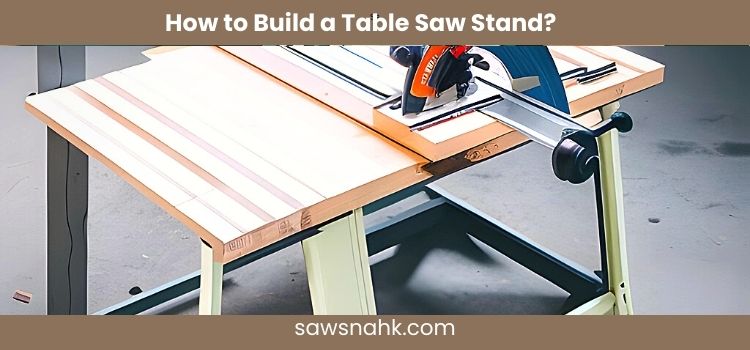How to Build a Table Saw Stand? Advanced Steps

Being a woodworker, whether professional or hobbyist, the relevance of a table saw in your projects cannot be overstated. However, even the best tool is rendered ineffective without a sturdy and dependable base to work from. This is where a well-crafted table saw stand comes into play.
Building a table saw stand may initially appear intimidating, especially for beginners. However, the process, which involves creating a durable frame from dimensional lumber and fitting it with a robust plywood tabletop, isn’t as complex as it sounds. While these steps might seem difficult to follow, this comprehensive guide aims to break down the procedure and aid you in crafting a functional table saw stand.
This guide also provides insights on choosing appropriate materials and tools, equipping you with all you need to bring your DIY project to life. So, let’s delve into the detailed process of building a table saw stand.
Necessary Tools and Materials
Just like every other DIY project, the outcome of your table saw stand is largely dependent on the tools and materials employed in the building process. Aim for perfection by ensuring you’ve prepared the following necessary items:
- Plywood sheets and 2×4 wood pieces
- Screws and wood glue
- Pocket hole screws
- Casters and leveling feet
- A circular saw and drill
- Pocket holes jig
- Miter saw
- Table saw
With all these items at your disposal, you’re ready to embark on the task of crafting your very own table saw stand.
Step-by-Step Guide to Building a Table Saw Stand
1. Settle on a Design for Your Stand
Every woodworker has a unique aesthetic sense, personal needs, and preferences, which greatly influence the final design of their DIY table saw stand. Before you begin cutting wood and other materials, it’s crucial to finalize the design of the stand. Keep in mind that the design should be tailored to your specific needs, including height requirements.
2. Cut the Stand Legs
After the design is ready, the first building step is to cut four 2x4s to serve as the legs of your DIY table saw stand. These should be of the same height as required for your tabletop. To ensure the legs sit flush with the top and to avoid any wobbling, cut the ends at a 45-degree angle.
3. Cut the Support Beams
Next, cut two pairs of 2x4s wood pieces that match the distance between the two legs. These pieces will serve as support beams and should be attached to the legs, ensuring they are leveled and secure.
4. Construct Cross Braces
The next step involves attaching cross braces to the stand for extra support. Use the same type of wood to build a pair of braces that measure the cross distance from one corner leg to another. Attach these braces in a crossed shape to enhance the stand’s durability and stability.
5. Create the Table Top
Measure and mark the plywood sheet that will form your tabletop. The size should meet your specific needs. After cutting the sheet as per your requirements, attach it to the support beams using screws and wood glue.
6. Add Additional Shelves
For those who desire more space in their DIY table saw stand, you can customize it further by adding shelves and other storage sections. Cut the plywood according to your size requirements and attach it to the support beams beneath the tabletop using pocket hole screws.
7. Install Leveling Feet or Casters
Adding casters to your stand will increase its mobility, while leveling feet are a great addition if your workshop floor tends to be uneven, resulting in wobbling. Based on your specific needs, attach either of these under the legs of the stand.
8. Finish and Test
You’re almost there! All you need to do now is sand any rough splinter or top edge to smoothen the surface. If you prefer consistency in your workshop design, you can paint the DIY table saw stand to match the color of your workshop walls or other tools. After completing all the above steps, it’s time to test the stand and make any necessary adjustments.
Helpful Tips for Building a DIY Table Saw Stand
Building a DIY table saw stand is not only a creative exercise but also a practical solution that can free up a significant amount of space in your workshop. Here are some useful tips to ensure accuracy and safety during the building process:
- Finalize the right design and dimensions to prevent any post-completion issues.
- Use durable and high-quality materials to ensure the longevity of the stand.
- Adding caster wheels can significantly increase the mobility of the stand.
- Ensure that your newly built stand is properly leveled to avoid wobbling issues.
- Always remember to wear safety gear while working on the project to prevent injuries.
Conclusion
Building a table saw stand may seem like a daunting task, but with the right tools, materials, and clear instructions, it becomes a straightforward process. This guide provides you with the basic steps to craft a compact table saw stand, from creating the legs and support beams, to building the tabletop, and finally, assembling all the parts together.
Furthermore, building your own stand offers you plenty of customization options, like adding a rip fence, blade guard, dust collection, and outfeed table. By listing down your specific needs and following the steps outlined in this guide, you will be able to create a stand that is both safe and long-lasting.
So, gear up and start building your own DIY table saw stand today. Enjoy your woodworking projects!
FAQS
How High Should A Table Saw Stand Be?
The portable table saw stand height depends on the user’s height and other concerns. But a 34 inches height is standard for such a jobsite table.
How To Build A Table Saw Workstation?
To build a table saw workstation, select the material, finalize the dimensions, and measure the wood for cutting. Construct the legs and beams, add a tabletop, make storage pieces, and sand the surface area.
Do You Need A Stand For A Table Saw?
A stand is not an inevitable part of working with the table saw, but it can help stabilize the wood pieces to make accurate cuts safely. So, adding the portable table saw stand to your workspace will free up some space also, along with the other benefits.
